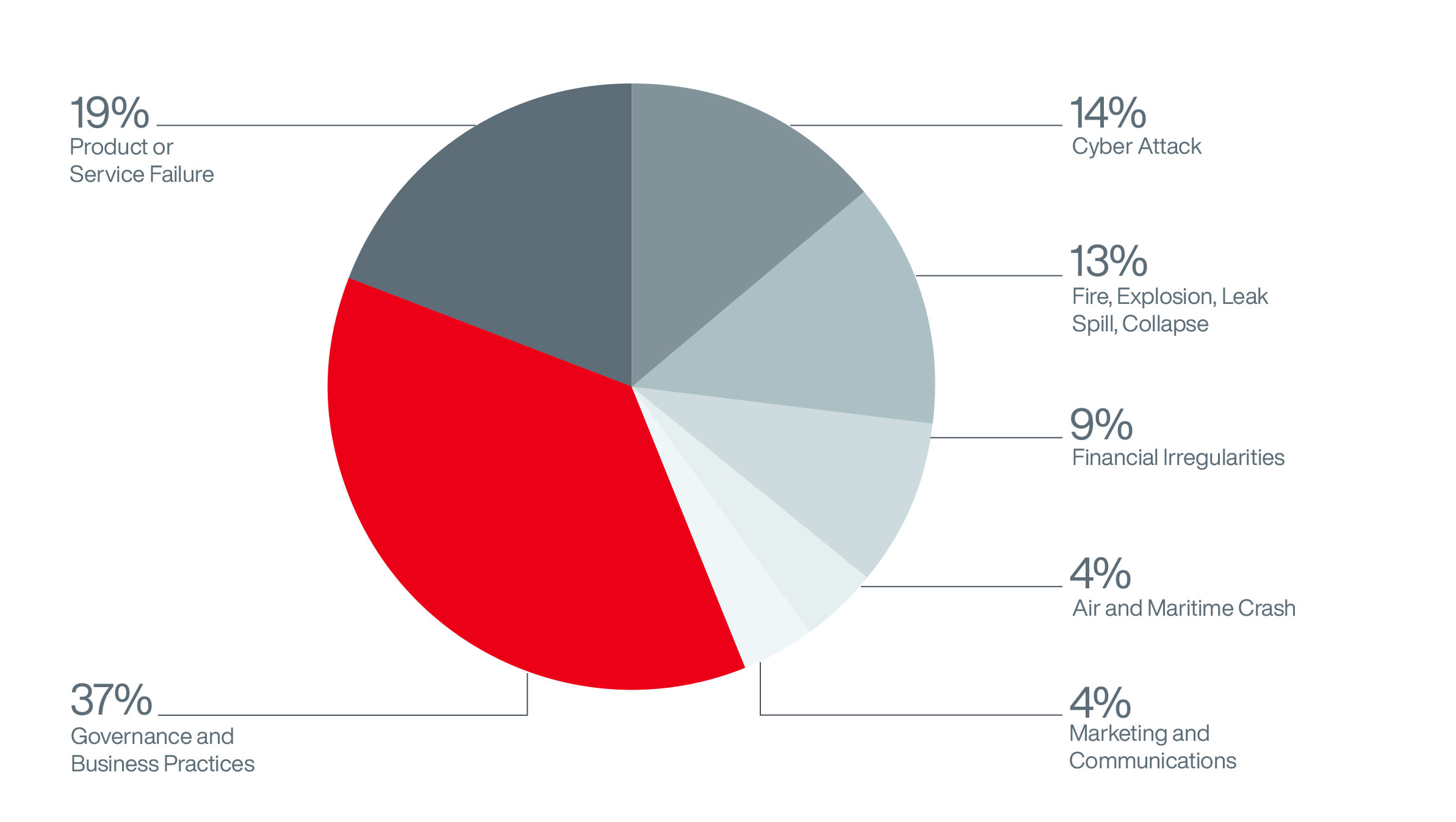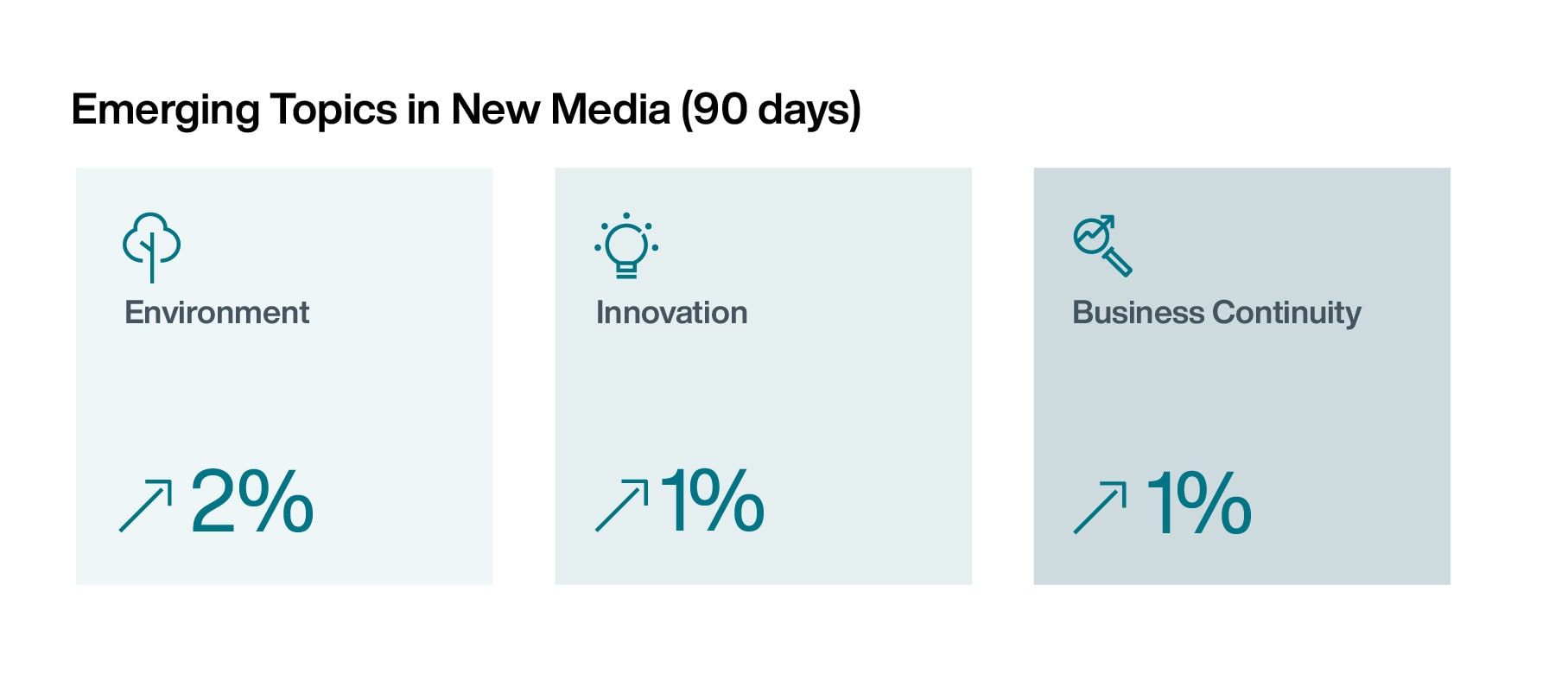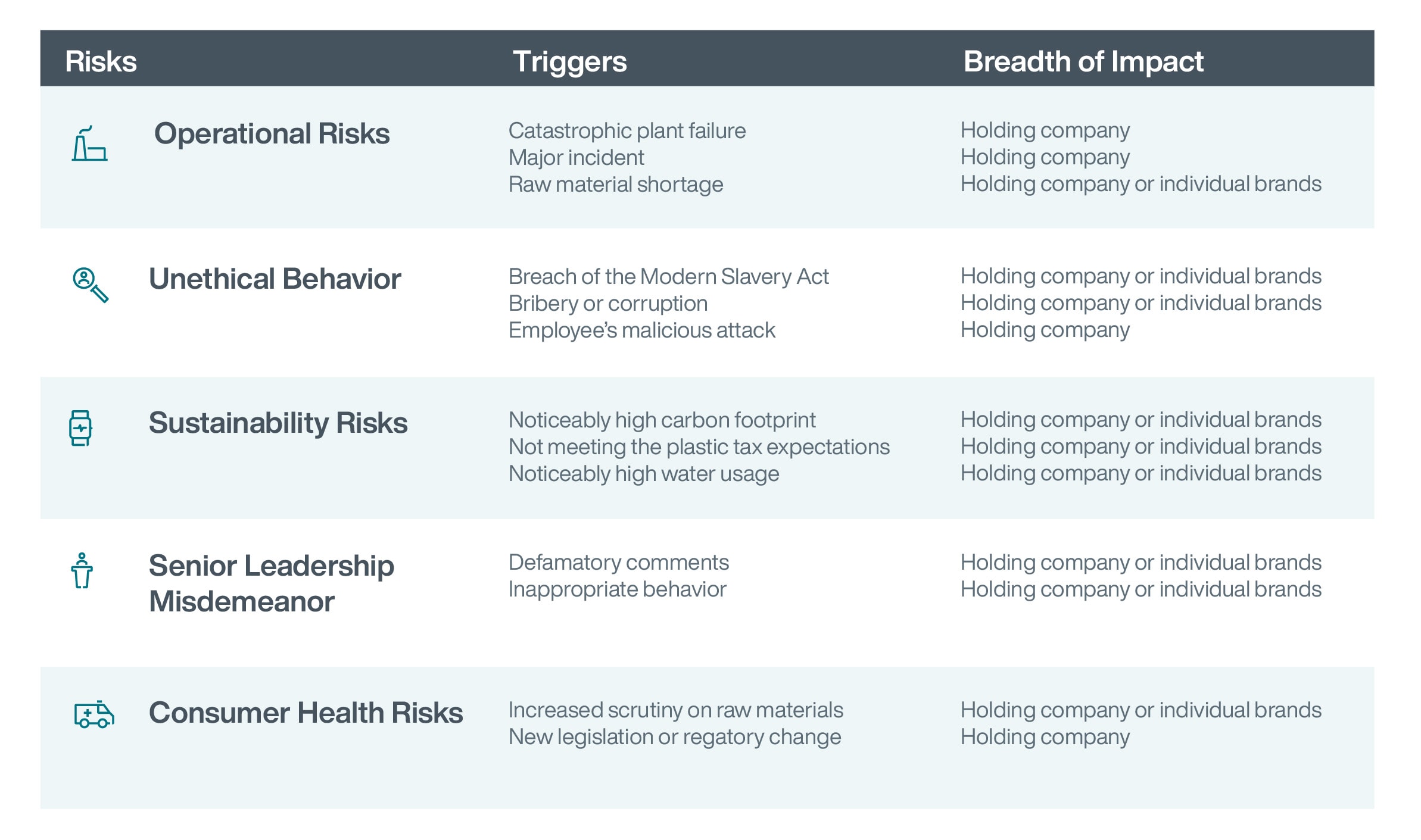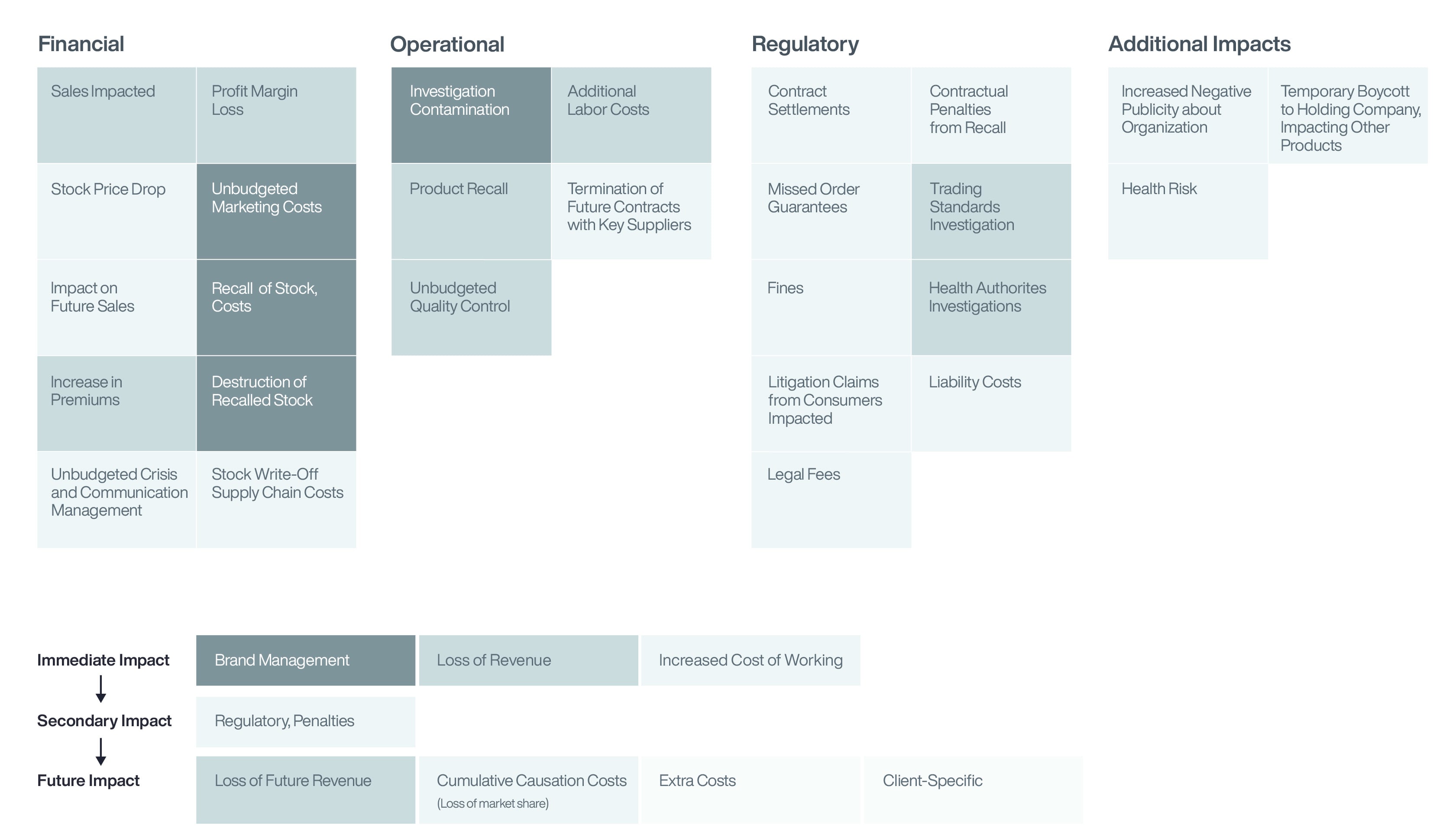26%
of shareholder value is lost at some point in the year following a major reputational crisis.
Source: Pentland Analytics' Respecting the Grey Swan

The potential reputation impact of environmental, social and governance (ESG) crises has never been higher, further amplified by interconnectivity, social media, and a 24/7 news cycle. In fact, reputation risk is now among the top five exposures for executives.
Termed Grey Swan events, reputation risk events tend to fall into one of seven categories, including lapses in business practices, product failures, cyber attacks, financial irregularities, and accidents such as fires, spills, and air/maritime crashes.
Yet, many businesses struggle to integrate traditionally non-financial ESG risks into traditional enterprise risk management frameworks, and as a result often inadequately manage them, despite the significant value typically tied up in reputation.
“When a reputation crisis occurs, the consequences can spiral,” says Richard Waterer, Global Risk Consulting leader for Aon’s Commercial Risk Solutions. “Trust is lost, and shareholder value is greatly impacted, impacting a company’s reputation and its ability to return to business as usual.”

Grey Swan events can have a dramatic impact on a company’s reputation and shareholder value. This is not only the case when your company is at the center of the crisis, but also when an entire sector is exposed to similar ESG risks as a company in crisis.
Among the corporate reputation crises spanning the last four decades, reputation crises destroyed more than 50% of value in in over 12 percent of cases, as well as $1.2 trillion in shareholder value across the entire 40-year period. The numbers present a compelling case for taking reputation risks seriously.
The evidence shows that shareholders can lose an average of 26 percent of value at some point during the year after a major reputation crisis. However, the magnitude of the impact on share price is not uniform but related to the market’s perception of the degree of ESG risk exposure and how well a company manages and communicates its efforts to mitigate risks.
“How leaders respond to a brand and reputational risk event can be a key indicator of the overall strength of their leadership and their underlying business – which can also act as a real-time ESG monitor,” says Jason Disborough, Aon’s CEO of Multinational Clients (International).
Reputation analytics help companies anticipate the short-term ESG-related risks impacting their sector and the broader market. Other ESG risk monitors tend to be backward looking and long-term in view. For example, in the ESG materiality assessments many companies focus their ESG strategy on taking a fixed view of ESG risk exposures, and ESG ratings and disclosure data are backwards looking.
In contrast, reputation analytics are driven by real-time headlines, employee sentiment, and current activism which may be more predictive of near-term ESG risks and serve as an important supplement to long-term ESG risk metrics. Often, headline ESG risks like workplace violence, greenwashing and human rights violations are not being captured sufficiently in corporate ESG strategies. Reputation risk monitors are most effective at surfacing these risks for companies to nimbly integrate into their risk management framework and ESG strategies.
Prior to a reputation event, Aon’s Digital Business Insights (DBI) can help organizations to get a clear and in-depth understanding of reputational risks and their impact by:
“Combining ESG data and tools in ratings, sentiment monitoring and disclosure with market-leading shareholder value impact as a result of a reputation event enables risk managers to not only better understand the past but to better prepare for the future,” says Laura Wanlass, Aon’s global head of Corporate Governance and ESG Advisory.
Using the insights gleaned from short-term reputation risk monitors and long-term ESG materiality assessments, companies can integrate nonfinancial risks into their enterprise risk management program. By taking the following steps, your company will be better positioned to manage short and long-term ESG risks and weather reputational crises effectively:


*Powered by Aon’s Digital Business Insights



The analysis of the above-mentioned critical insights can help organizations to better forecast upcoming risks, determine an optimal risk management strategy and make better decisions around investments in early intervention.
“Reputation risk is indeed quantifiable. Through reputation risk analytics, the true net impact that a reputation crisis has on shareholder value as well as on competitors becomes clearer,” Disborough explains.
“Companies that are able to leverage such real-time reputation risk data can forecast, navigate, prioritize and address evolving ESG risks and opportunities at all phases of their journey, adjusting their strategies to match,” he adds. “They can manage and treat reputation risk exposures, recover and enhance their share price, protecting their enterprise value in the long run.”
of shareholder value is lost at some point in the year following a major reputational crisis.
Source: Pentland Analytics' Respecting the Grey Swan
When the LIBOR scandal came to light, two culpable global financial institutions took very different approaches to reputation management – with very different consequences. By acting decisively and realigning its ESG priorities, Financial Institution 1 weathered the scandal and not only recovered shareholder value but drove it beyond pre-crisis levels.
Financial Institution 1 jumped into action, made key decisions quickly, and committed to change.
Impact:
Financial Institution 2 was slow to act and demonstrated weak leadership and a lack of transparency.
Impact:
Valuing your firm’s reputation can help you protect its market value. Want to make better brand and reputation risk management decisions? Visit https://www.aon.com/solutions/commercial-risk/reputation-risk-analytics.
If you would like to discuss any aspects of these insights please do not hesitate to get in contact with our team.
Richard Waterer
Global Risk Consulting Leader
[email protected]
Ladd Muzzy
Director – Consulting
[email protected]
Laura Wanlass
Global Head of Corp. Gov & ESG
[email protected]
Jason Disborough
CEO – Multinational Clients (International) and Enterprise Client Leader
[email protected]
Martin McGovern
Director - Actuarial and Data Science
[email protected]
General Disclaimer
The information contained herein and the statements expressed are of a general nature and are not intended to address the circumstances of any particular individual or entity. Although we endeavor to provide accurate and timely information and use sources we consider reliable, there can be no guarantee that such information is accurate as of the date it is received or that it will continue to be accurate in the future. No one should act on such information without appropriate professional advice after a thorough examination of the particular situation.
Terms of Use
The contents herein may not be reproduced, reused, reprinted or redistributed without the expressed written consent of Aon, unless otherwise authorized by Aon. To use information contained herein, please write to our team.
Our Better Being podcast series, hosted by Aon Chief Wellbeing Officer Rachel Fellowes, explores wellbeing strategies and resilience. This season we cover human sustainability, kindness in the workplace, how to measure wellbeing, managing grief and more.
Expert Views on Today's Risk Capital and Human Capital Issues
Expert Views on Today's Risk Capital and Human Capital Issues
Expert Views on Today's Risk Capital and Human Capital Issues
The construction industry is under pressure from interconnected risks and notable macroeconomic developments. Learn how your organization can benefit from construction insurance and risk management.
Stay in the loop on today's most pressing cyber security matters.
Our Cyber Resilience collection gives you access to Aon’s latest insights on the evolving landscape of cyber threats and risk mitigation measures. Reach out to our experts to discuss how to make the right decisions to strengthen your organization’s cyber resilience.
Our Employee Wellbeing collection gives you access to the latest insights from Aon's human capital team. You can also reach out to the team at any time for assistance with your employee wellbeing needs.
Explore Aon's latest environmental social and governance (ESG) insights.
Our Global Insurance Market Insights highlight insurance market trends across pricing, capacity, underwriting, limits, deductibles and coverages.
How do the top risks on business leaders’ minds differ by region and how can these risks be mitigated? Explore the regional results to learn more.
Our Human Capital Analytics collection gives you access to the latest insights from Aon's human capital team. Contact us to learn how Aon’s analytics capabilities helps organizations make better workforce decisions.
Explore our hand-picked insights for human resources professionals.
Our Workforce Collection provides access to the latest insights from Aon’s Human Capital team on topics ranging from health and benefits, retirement and talent practices. You can reach out to our team at any time to learn how we can help address emerging workforce challenges.
Our Mergers and Acquisitions (M&A) collection gives you access to the latest insights from Aon's thought leaders to help dealmakers make better decisions. Explore our latest insights and reach out to the team at any time for assistance with transaction challenges and opportunities.
How do businesses navigate their way through new forms of volatility and make decisions that protect and grow their organizations?
Our Parametric Insurance Collection provides ways your organization can benefit from this simple, straightforward and fast-paying risk transfer solution. Reach out to learn how we can help you make better decisions to manage your catastrophe exposures and near-term volatility.
Our Pay Transparency and Equity collection gives you access to the latest insights from Aon's human capital team on topics ranging from pay equity to diversity, equity and inclusion. Contact us to learn how we can help your organization address these issues.
Forecasters are predicting an extremely active 2024 Atlantic hurricane season. Take measures to build resilience to mitigate risk for hurricane-prone properties.
Our Technology Collection provides access to the latest insights from Aon's thought leaders on navigating the evolving risks and opportunities of technology. Reach out to the team to learn how we can help you use technology to make better decisions for the future.
Trade, technology, weather and workforce stability are the central forces in today’s risk landscape.
Our Trade Collection gives you access to the latest insights from Aon's thought leaders on navigating the evolving risks and opportunities for international business. Reach out to our team to understand how to make better decisions around macro trends and why they matter to businesses.
With a changing climate, organizations in all sectors will need to protect their people and physical assets, reduce their carbon footprint, and invest in new solutions to thrive. Our Weather Collection provides you with critical insights to be prepared.
Our Workforce Resilience collection gives you access to the latest insights from Aon's Human Capital team. You can reach out to the team at any time for questions about how we can assess gaps and help build a more resilience workforce.

Article 8 mins
U.S. freight and commuter rail industries are facing excess liability and property issues for different reasons. These railroads are critical to infrastructure and vital to the economy, yet finding effective solutions remains complex.

Article 11 mins
As private companies prepare for an IPO, they face increased risks that require directors and key leaders to adopt essential risk management strategies to ensure a smooth transition.

Article 10 mins
As climate change intensifies the frequency and severity of extreme weather events, public entities and businesses need more flexible funding solutions. Parametric stands out as an adaptable resource capable of swiftly responding to potential disasters.